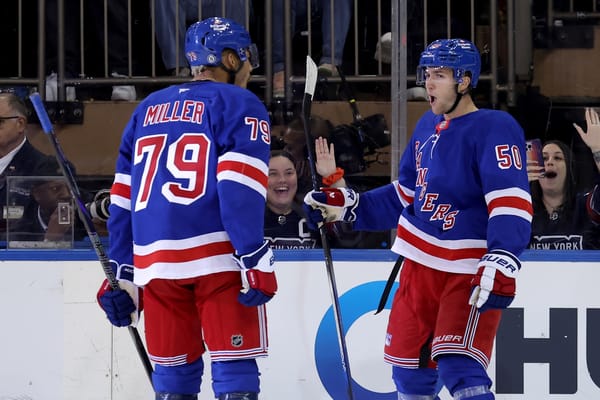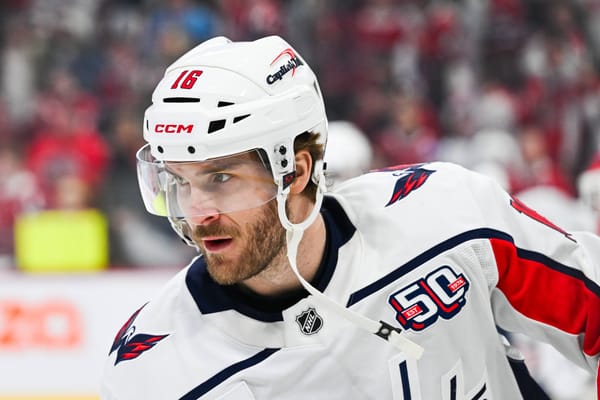What Have We Learned: A Look at Games 37-42
Six games later and the New York Rangers have officially passed the midpoint of the season and now are on a much needed bye week. We last left off with a loss to the Toronto Maple Leafs on December 23rd. Since then, the Rangers have matched up against the Washington Capitals, Detroit Red Wings, Buffalo Sabres, Chicago Blackhawks, Arizona Coyotes, and Vegas Golden Knights.
Six games and seven points later, and the flaws of this team are showing more than ever. The Rangers have been complacent, moved backwards and haven’t learned nearly enough from the first 36 games. But this isn’t anything new, and these flaws aren’t limited to this span of games or even this season – they’ve been evident for the past few years if you have been paying attention.
The Rangers came into their matchup against the Capitals with some tweaks to their lineup. The first line consisted of Rick Nash, Mika Zibanejad and Mats Zuccarello. Michael Grabner reunited with Kevin Hayes and J.T. Miller. David Desharnais skated between Chris Kreider and Jimmy Vesey. Boo Nieves and Paul Carey remained on the fourth line, and were joined by an (unfortunately) familiar face, Pavel Buchnevich.
Finally, some changes were made on defense as well – except the pair that most needed some changes, Ryan McDonagh and Nick Holden, were the only pair left in tact. Marc Staal shifted to the right to play with Brady Skjei, while the third pair consisted of two players that received new contracts with the Rangers this offseason – Brendan Smith and Kevin Shattenkirk
Kreider left the game after the first period, and it was announced the following day that he’d be out indefinitely with a blood clot. Fourth-liner Buchnevich moved up to take his place in the lineup. Overall, it was a better effort from the Rangers; they actually led the Capitals in shots on goal (37-30) and 5v5 shot attempts (49-43). Ondrej Pavelec’s kept the Capitals off of the scoresheet, and it took a shootout for the Rangers to earn a 1-0 win.
Two days later, the Rangers traveled to Detroit. Vinni Lettieri was recalled from Hartford and slotted into Buchnevich’s place on the fourth line, while Buchnevich maintained Kreider’s place in the lineup. One of the few highlights of the night was Lettieri scoring his first NHL goal in his first NHL game, but it wasn’t enough. The Rangers fell in the shootout to the Red Wings.
The next game was the Winter Classic. Jesper Fast returned from injury, taking Lettieri’s place on the fourth line. While the Rangers had a strong first period where they earned a 2-0 lead and took 60.71 percent of the shot attempts, the next 40 minutes weren’t as productive. The Sabres not only improved their offensive generation, but tied the game and forced overtime. Shattenkirk and Zuccarello assisted Miller on the game-winning power play goal, which allowed the Rangers to maintain their perfect outdoor record.
In the usual surroundings, this may have been an easier game with fewer expectations. But it wasn’t, and both teams knew that. The Rangers should have risen to the occasion beyond the first 20 minutes. A win is a win and two points are two points, but it wasn’t encouraging to see the Rangers have such a lackluster 40 minutes against the worst team in the Eastern Conference.
Back indoors and at Madison Square Garden, the Rangers were challenged by the Blackhawks. After 60 painful minutes for the Rangers, the Blackhawks won 5-2. They led with 64.58 percent of the 5v5 shot attempts, while the Rangers only accumulated 35.42. The disparity in shots on goal was even worse (68.29 percent to 31.71 percent). Yet again, the team let their goaltender down, despite the fact that he played better than the goalie who collected the win. It didn’t help that Lundqvist faced nine high-danger shots at 5v5 (only two of which ended up in the back of the net), while the Rangers didn’t challenge Jeff Glass with a single one.
A loss like that rightfully prompted line changes before their tilt in Arizona. Zuccarello was held out sick, so Lettieri slotted back into the lineup on the fourth line with Carey and Nieves (although he moved up the lineup as the game progressed). Grabner, Hayes, and Fast skated together, while Nash joined Vesey and Desharnais. Buchnevich and Zibanejad’s chemistry was actually acknowledged, and they were put together on the first line along with Miller. It was finally a step in the right direction for the forward lines, but it didn’t last long.
After such a poor defensive effort the last game, the pairs were changed... back to what they were before these last few games, with Skjei and Shattenkirk as the second pair and Smith and Staal back on the third pair – even though those had become stagnant and lost their effectiveness over time.
The Rangers craved offense versus the league-worst Coyotes, so the coaches found the best solution: moving Buchnevich back to the fourth line early in the game and putting Fast on the first line. The story was the same: the defense wasn’t good enough, the offense wasn’t creating enough, and Lundqvist was the difference-maker again. They escaped with two points in the shootout, but it wasn’t a win that the team should be proud of.
Finally, the Rangers traveled to Vegas to face off against the best team in the Western Conference. Fast maintained his first line role, Carey somehow started the game on the second line with Hayes and Zuccarello, Grabner moved to the fourth line with Nieves and Lettieri, and the third line was maintained. A certain player was missing… Oh! The team’s third highest scorer, Buchnevich! He was in the press box, alongside Smith who was scratched for Steven Kampfer.
As expected, this wasn’t a good game for the Rangers. Losing Hayes early in the game to a lower-body injury didn’t help, putting the Rangers without three of their most productive forwards (one of which was by choice, oddly enough!). The Rangers conceded 69.7 percent of the shot attempts in the first period and 62.86 in the second period; their only redeemable period was the third. And thanks to a number of inexplicable defensive breakdowns, Pavelec continuously had to make big saves while facing numerous odd-man rushes. Really, the Rangers were lucky the final score was only 2-1 (and should, as always, be thanking their tandem in net and goaltending coach extraordinaire Benoit Allaire).
So what have we learned? Well, we’ve learned that this team still isn’t a strong enough contender, and it’s the same issues plaguing them season after season. Six games later and the Rangers haven’t earned a regulation win. In fact, it’s been eight games since the Rangers earned a regulation win or scored four goals in a game – they haven’t managed that since their December 19th matchup against the Anaheim Ducks. The Rangers aren’t winning games decisively, and really didn’t deserve the most of the points they’ve earned in these games. Game after game it’s the same story, and it stems from one place: behind the bench.
It’s easy to point the finger at the coaching staff, but it’s hard to look anywhere else right now.
Without Kreider, possibly for the rest of the season, the Rangers really have to assess whether they’re playoff contenders. Right now it doesn’t really seem to be the case, despite what the standings reflect. Before jumping to acquire another forward to fill the void left by Kreider, it’s important to look at who can step up within the lineup first.
There’s one clear option that stands out – one that hasn’t received the top-six minutes he deserves: Pavel Buchnevich.
Buchnevich may be the most dynamic forward on the Rangers’ roster. His offensive abilities are exceptional, particularly his vision, playmaking, passing abilities, speed, and his shot. Although his ice time hasn’t been high, he’s the third-highest scorer on this team with 26 points in 41 games. At 5v5, he leads the team with 17 points, a 2.18 point per hour scoring rate, and 53.56 expected goals for percentage (plus-5.99 relative). His 49.89 Corsi for percentage (plus-4.56 relative) is second, as is his 59.51 Corsi for per 60 and 15.65 individual Corsi for per 60, while his 58.82 goals for percentage (plus-9.22 relative) is third on the team.
This is the player that the Rangers should be looking to for an offensive boost. Instead, he was primarily in the bottom-six this week – if he was in the lineup at all. And when he finally got a look at the first line – with Zibanejad, who head coach Alain Vigneault noted he had chemistry with – he was demoted after the first period, because that is apparently enough time to decide he deserves a demotion – not to the second or third lines, but to the fourth.
Speaking of Zibanejad, he didn’t instantly regain his scoring touch when returning from a concussion. It takes time for player to get back into the swing of things, but it probably didn’t help that he didn’t get much time with the players he was most accustomed to playing with. When he finally did break his scoring slump, it was a beautiful pass from Buchnevich on the power play that led to his first goal since November 22nd.
But the Rangers have their own “sophisticated stat package” – and those stats should indicate which players are consistently the best performers on this team, one of whom is unquestionably Buchnevich. But they clearly don’t. Or they do, and Vigneault ignores them to play his guys. It happened last year with Buchnevich, and it’s happening again this year. (And this is to say nothing of almost every other forward that didn’t prioritize defense over offense – in New York and Vancouver).
Whenever the Rangers struggle, Vigneault’s go-to move is demoting Buchnevich – even when he isn’t the problem. This week, players like Fast were replacing him on the first line. Fast has exceeded offensive expectations this season, but he doesn’t belong on the first line. Lettieri was guilty of a potentially game-ending turnover Saturday but wasn’t penalized (and maybe he shouldn’t be, but should he have been promoted for it or even used in overtime in the first place?). And Sunday, Carey was moved up to the second line while Buchnevich was moved out of the lineup and into the pressbox.
How is this defensible?
The fact is that the Rangers either haven’t found the most optimal combinations or haven’t maintained ones that have found success together. But that’s been the case throughout Vigneault’s tenure in New York. And as problematic as the combinations are, so is the distribution of ice time. And that was clear this week as they didn’t generate nearly enough offense this week to earn decisive wins – they didn’t score any goals against the Capitals, two against the Red Wings, three against the Sabres, two against the Blackhawks, one against the Coyotes, and one against the Golden Knights.
Deploying a questionable lineup wasn’t exclusive to the offense though. There were a number of questionable decisions made on defense as well – starting with keeping the first pair intact. Why haven’t the coaches noticed after 387.82 5v5 minutes that this pair isn’t strong enough to be a first pair? It’s especially puzzling since there are better options to play with McDonagh in this lineup. It’s all been said before though, it’s clear via the eye test, and the numbers support it as well. Breaking up that pair gives the Rangers more pairing options. But instead, the bottom four have been shifted around while this pair has been a mainstay.
Skjei with Staal is an interesting pair, especially because Staal is playing on his off side. They weren’t exactly successful in their first game together but excelled against both Detroit and Buffalo. Against Chicago, though, this pair particularly struggled. The Skjei-Staal pair either thrived or floundered, and that inconsistency was reason enough to dismantle the pair.
So Skjei was shifted back to Shattenkirk’s left. Being paired with Skjei at least moved Shattenkirk off of the third pair, something he’s needed to become accustomed to the with the Rangers. General manager Jeff Gorton must have had that in mind when he signed Shattenkirk to a four year, $26.6 million contract this offseason. He also probably thought Smith deserved third pair minutes and press box time when he acquired Brendan Smith for a second and third-round draft pick and extended him for four years at $17.4 million this offseason.
Shattenkirk has struggled as of late, there’s no question. But what’s more indicative of his capabilities? An impressive career that enticed the Rangers to sign him, or this recent string of games? Then again, what else you should expect from a “work in progress” when the coaches consistently express so much confidence in his abilities?
As for Smith, while the Rangers have yet to find a lasting defense pairing for him, he’s improved his play since returning to the lineup. However, his ice time is consistently towards the bottom of the charts each game. And it’s not as if his performance in recent games was concerning, especially when looking at how the rest of the defense has played, or warranted becoming a healthy scratch.
Meanwhile, Kampfer is last in Corsi for percentage (42.64, minus-6.55 relative) through the 14 games he has played this season. Additionally, he has been on the ice for the most shot attempts against (68.41 per 60); it’s worth noting for context that he has the second-lowest zone start ratio on the team (37.8). The fact that the coaches utilize him in this role despite his detrimental play may be the most concerning part of him being in the lineup.
Against the best team in the Western Conference, the personnel decisions made no sense. And the fact that the Rangers feel that this is what will give them the best chance shows exactly why their chances at success this season aren’t just dwindling, but plummeting.
The Rangers roster certainly has its flaws, but those flaws are more apparent than ever when the players that are available to the coaches aren’t deployed adequately. This roster needs some modifications to be a truly competitive team, but those changes are useless if they aren’t going to be used correctly and are instead forced to emulate a system that has damaged the Rangers’ chances over the last few years.
It’s just past the midway point of the season and the Rangers look to be in the same position as the past few seasons. Gorton now has to decide whether the team he’s assembled can deviate from their recent history that appears to be repeating itself. The first step to improving is to find the optimal lineup combinations; only then can they truly assess their needs and understand if they have a chance at hoisting the Stanley Cup. If they don’t, why risk overleveraging the team’s future, especially when all evidence points to the returns being utilized incorrectly?
Until something finally changes, the Rangers are just delaying the inevitable – another premature elimination, more roster dismantling, and another year of Lundqvist’s career wasted. What’s the point?
*Data is at 5v5, via Corsica.hockey




